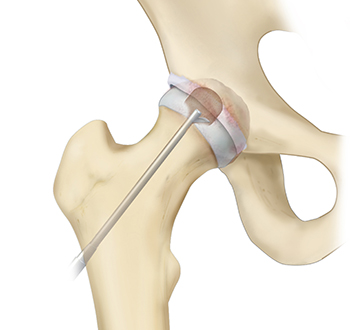Avascular Necrosis (AVN) Surgical Treatments
What are the surgical options for AVN?
If conservative treatment for AVN fails or in more advanced stages of AVN, surgical intervention is an option that may be discussed during your consultation with Dr. Chahla. The surgical options for AVN of the hip include core decompression, osteochondral grafting, vascularized fibula graft, and hip replacement.
A minimally invasive procedure that involves drilling a hole into the femoral head to relieve the pressure within the bone. The decreased pressure allows the vasculature to re-supply the damaged bone. This procedure also creates new channels for blood vessels to supply nutrients and oxygen to the dead bone. Core decompression is most effective in cases that are diagnosed early before the bone collapses. In most cases, we recommend using stem cells (bone marrow aspirate concentrate) to aid in a better biological milieu.

Replacement of the dead bone and damaged cartilage with healthy bone and cartilage from another bone in the body (autograft) or from a donor (allograft). This procedure replaces the defect, provides mechanical support, and re-introduces a smooth cartilage joint surface. Stem cells are often extracted from other parts of the body and injected into the joint during this procedure to promote bone and cartilage healing as well as reduce inflammation.
A segment of the small bone in your leg (fibula) along with its blood supply (artery and vein) is grafted and inserted it into the area of osteonecrosis within the femoral head. The artery and vein from the fibula graft are reattached to the blood supply of the hip and provide oxygen and nutrients to heal the area.
The most effective treatment in late-stage cases of AVN where the bone has already collapsed. This procedure involves removing the damaged femoral head (ball) and part of the acetabulum (socket) and replacing it with prosthetic implants that restore the function of the joint. This procedure is performed by a joint replacement surgeon.
Initially, it will be essential that you do not put weight on the operative side for 6-12 weeks following surgery. Sutures are usually removed during a follow-up appointment scheduled about two weeks after surgery, and additional appointments are usually scheduled in 6 week increments so Dr. Chahla can monitor the progress of the bone healing based off your symptoms, X-rays, and possibly an MRI if needed. Beginning immediately after your hip surgery, you will start physical therapy to work on range of motion of the hip. It is recommended to continue attending physical therapy for 4-6 months following the core decompression. Typically, full recovery following a core decompression of the femoral head to treat AVN is about 6 months.
If AVN progresses to advanced stages, surgical intervention may be required to relieve pain and restore joint function. Treatment options include core decompression, bone grafting, or total hip replacement for severe cases. Dr. Jorge Chahla is an expert in hip preservation and reconstruction, utilizing advanced surgical techniques to improve long-term joint health. If non-surgical treatments have not provided relief, schedule a consultation at Dr. Chahla’s office in Chicago, Naperville, or Oak Brook to explore your surgical options.
At a Glance
Dr. Jorge Chahla
- Triple fellowship-trained sports medicine surgeon
- Performs over 800 surgeries per year
- Associate professor of orthopedic surgery at Rush University
- Learn more

